Birds
Media

Species Types
Scientific Name
Setophaga castanea (formerly Dendroica castanea)
Description
The male bay-breasted warbler is easy to identify, while females and nonbreeding males present a challenge. This species migrates through Missouri in spring and fall.
Media

Species Types
Scientific Name
Sitta carolinensis
Description
White-breasted nuthatches, the upside-down birds, creep up and down tree trunks and on the tops and bottoms of branches. The call is a nasal “yank” or “yank-yank.”
Media
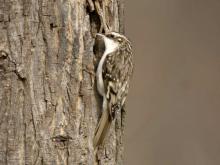
Species Types
Scientific Name
Certhia americana
Description
Like a wren that behaves like a woodpecker, the brown creeper is a small brown and white bird that creeps in upward spirals around the trunks of trees, using its tail as a prop.
Media
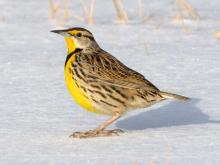
Species Types
Scientific Name
Sturnella magna
Description
In prairies and other open grassy areas, eastern meadowlarks sing sweet, slurring songs from fence posts and power lines. Note the long, sharp bill and the yellow breast with black V-shaped marking.
Media
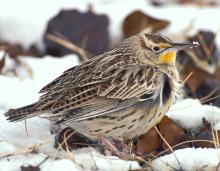
Species Types
Scientific Name
Sturnella neglecta
Description
The western meadowlark is less common in Missouri than the eastern meadowlark. Slightly paler and with a very different song, it’s a permanent resident only in the northwest corner of the state.
Media

Species Types
Scientific Name
Icterus spurius
Description
The orchard oriole is a common summer resident in Missouri. Males are rusty and black; females are olive green and yellowish. Look for them high in trees in places with scattered trees, especially near water.
Media
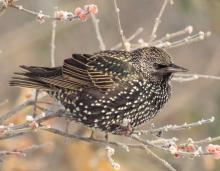
Species Types
Scientific Name
Sturnus vulgaris
Description
Few Americans love this bold nonnative bird, purposefully introduced to our continent in the late 1800s and now abundant throughout our country.
Media

Species Types
Scientific Name
Passerina cyanea
Description
One of the most colorful birds in Missouri, the indigo bunting is frequently seen flying up from gravel roads. It is one of the most abundant and easily seen and heard birds in the state.
Media
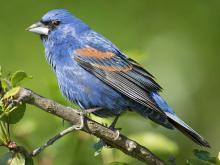
Species Types
Scientific Name
Passerina caerulea (formerly Guiraca caerulea)
Description
The male blue grosbeak is one of Missouri’s most colorful birds, but it is uncommon. To see one, learn to recognize its voice, and visit likely habitats in the Ozarks, May–September.
Media

Species Types
Scientific Name
Passer domesticus
Description
The house sparrow was brought to America from Europe, but instead of controlling insect pests, it became a pest itself. Also called the English sparrow, its hordes compete with native birds for nesting sites.
See Also







Media

Species Types
Scientific Name
Hemaris diffinis
Description
The snowberry clearwing is a moth that confuses people because it looks like a bumblebee and flies like a hummingbird!
Media

Species Types
Scientific Name
Hyles lineata
Description
The white-lined sphinx moth sometimes confuses people because it flies, hovers, and eats from flowers like a hummingbird. The adults often fly during daylight hours as well as in the night and are often found at lights.
Media

Species Types
Scientific Name
Darapsa myron
Description
The Virginia creeper sphinx moth is common in woods and brushy areas and comes to lights at night. The larvae eat Virginia creeper and grape leaves.
Media

Species Types
Scientific Name
Perimyotis subflavus (formerly Pipistrellus subflavus)
Description
Tri-colored bats, formerly called eastern pipistrelles, are relatively small and look pale yellowish or pale reddish brown. The main hairs are dark gray at the base, broadly banded with yellowish brown, and tipped with dark brown.
Media

Species Types
Scientific Name
Myotis grisescens
Description
Gray myotises are difficult to distinguish from other mouse-eared bats. A key identifying feature of the gray myotis is that its wing is attached to the ankle and not at the base of the toes. It’s an endangered species.
Media

Species Types
Scientific Name
Myotis lucifugus
Description
The little brown myotis (little brown bat) is one of our most common bats, but populations are declining. White-nose syndrome has taken a heavy toll in northeastern states. This species is now listed as vulnerable across its range.
Media

Species Types
Scientific Name
Myotis sodalis
Description
The Indiana myotis, or Indiana bat, summers along streams and rivers in north Missouri, raising its young under the bark of certain trees. It is an endangered species.
About Birds in Missouri
About 350 species of birds are likely to be seen in Missouri, though nearly 400 have been recorded within our borders. Most people know a bird when they see one — it has feathers, wings, and a bill. Birds are warm-blooded, and most species can fly. Many migrate hundreds or thousands of miles. Birds lay hard-shelled eggs (often in a nest), and the parents care for the young. Many communicate with songs and calls.





















